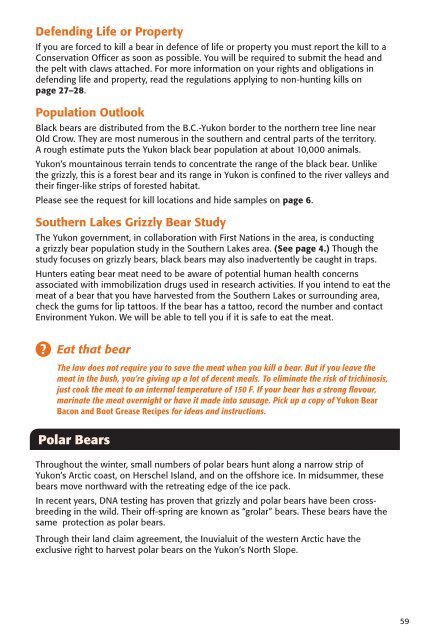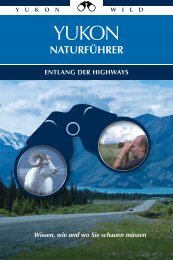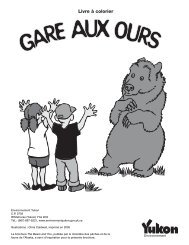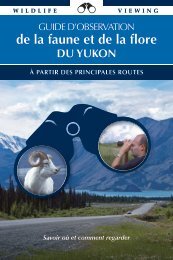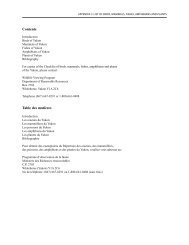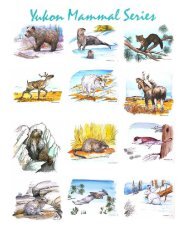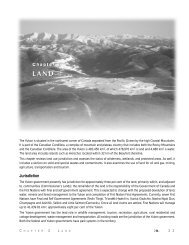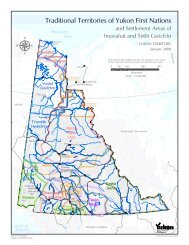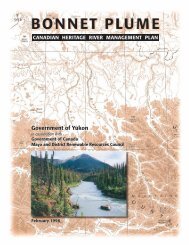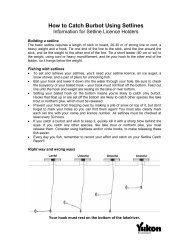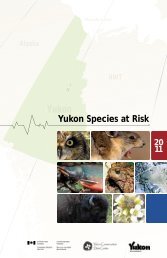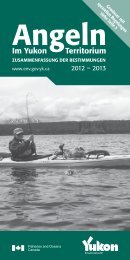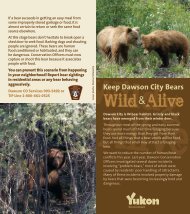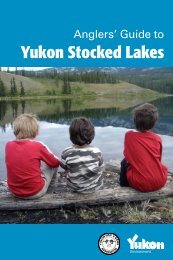Yukon Hunting - Department of Environment - Government of Yukon
Yukon Hunting - Department of Environment - Government of Yukon
Yukon Hunting - Department of Environment - Government of Yukon
You also want an ePaper? Increase the reach of your titles
YUMPU automatically turns print PDFs into web optimized ePapers that Google loves.
Defending Life or Property<br />
If you are forced to kill a bear in defence <strong>of</strong> life or property you must report the kill to a<br />
Conservation Officer as soon as possible. You will be required to submit the head and<br />
the pelt with claws attached. For more information on your rights and obligations in<br />
defending life and property, read the regulations applying to non-hunting kills on<br />
page 27–28.<br />
Population Outlook<br />
Black bears are distributed from the B.C.-<strong>Yukon</strong> border to the northern tree line near<br />
Old Crow. They are most numerous in the southern and central parts <strong>of</strong> the territory.<br />
A rough estimate puts the <strong>Yukon</strong> black bear population at about 10,000 animals.<br />
<strong>Yukon</strong>’s mountainous terrain tends to concentrate the range <strong>of</strong> the black bear. Unlike<br />
the grizzly, this is a forest bear and its range in <strong>Yukon</strong> is confined to the river valleys and<br />
their finger-like strips <strong>of</strong> forested habitat.<br />
Please see the request for kill locations and hide samples on page 6.<br />
Southern Lakes Grizzly Bear Study<br />
The <strong>Yukon</strong> government, in collaboration with First Nations in the area, is conducting<br />
a grizzly bear population study in the Southern Lakes area. (See page 4.) Though the<br />
study focuses on grizzly bears, black bears may also inadvertently be caught in traps.<br />
Hunters eating bear meat need to be aware <strong>of</strong> potential human health concerns<br />
associated with immobilization drugs used in research activities. If you intend to eat the<br />
meat <strong>of</strong> a bear that you have harvested from the Southern Lakes or surrounding area,<br />
check the gums for lip tattoos. If the bear has a tattoo, record the number and contact<br />
<strong>Environment</strong> <strong>Yukon</strong>. We will be able to tell you if it is safe to eat the meat.<br />
Eat that bear<br />
The law does not require you to save the meat when you kill a bear. But if you leave the<br />
meat in the bush, you’re giving up a lot <strong>of</strong> decent meals. To eliminate the risk <strong>of</strong> trichinosis,<br />
just cook the meat to an internal temperature <strong>of</strong> 150 F. If your bear has a strong flavour,<br />
marinate the meat overnight or have it made into sausage. Pick up a copy <strong>of</strong> <strong>Yukon</strong> Bear<br />
Bacon and Boot Grease Recipes for ideas and instructions.<br />
Polar Bears<br />
Throughout the winter, small numbers <strong>of</strong> polar bears hunt along a narrow strip <strong>of</strong><br />
<strong>Yukon</strong>’s Arctic coast, on Herschel Island, and on the <strong>of</strong>fshore ice. In midsummer, these<br />
bears move northward with the retreating edge <strong>of</strong> the ice pack.<br />
In recent years, DNA testing has proven that grizzly and polar bears have been crossbreeding<br />
in the wild. Their <strong>of</strong>f-spring are known as “grolar” bears. These bears have the<br />
same protection as polar bears.<br />
Through their land claim agreement, the Inuvialuit <strong>of</strong> the western Arctic have the<br />
exclusive right to harvest polar bears on the <strong>Yukon</strong>’s North Slope.<br />
59


